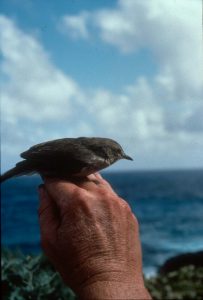Nihoa Millerbird

Names
- ʻŌlelo Hawaiʻi: Ulūlu
- Common: Nihoa Millerbird
- Scientific: Acrocephalus familiaris
Song
Conservation Status
- Federally Listed as Endangered
- State Listed as Endangered
- State Recognized as Endemic
- NatureServe Heritage Rank G1—Critically Imperiled
- IUCN Red List Ranking—Critically Endangered
- Northwestern Hawaiian Islands Passerines Recovery Plan—USFWS 1984
Species Information

Nihoa millerbird.
The Nihoa millerbird is an obligate insectivore endemic to Nihoa Island in the Northwestern Hawaiian Islands. The Nihoa millerbird and its relative, the Laysan millerbird, are the only known Old World warblers (subfamily Sylviinae) known to have colonized the Hawaiian Archipelago. The Laysan subspecies, discovered first, was named “millerbird” because of its fondness for feeding on large miller moths (Family Noctuidae). Although the Laysan subspecies was driven to extinction by 1923 after European rabbits (Oryctolagus cuniculus) were introduced to Laysan in 1903, the Nihoa millerbird has persisted. Nihoa millerbirds are small (about 13 centimeters, or about 5 inches, in length), dulled colored, and highly active due to their insectivorous habits. Male and female Nihoa millerbirds have similar plumage, but differ in size, with males being slightly larger than females. Nihoa millerbirds feed exclusively on insects and larvae, especially moths and caterpillars (Lepidoptera), gleaned from shrubs and bunchgrass tussocks. Like most insectivores, Nihoa millerbirds are territorial, and display a high degree of year-to-year territory fidelity. During breeding season, both sexes construct nests and incubate eggs.
Distribution
Nihoa millerbirds are now restricted to the approximately 63 hectares (156 acres) area of Nihoa Island. Of those 63 hectares, approximately 40 hectares (100 acres) are considered suitable habitat for millerbird territories. Nihoa Island can support, on average, between 100 and 200 millerbird territories. A small population of Nihoa millerbirds was translocated from Nihoa Island to Laysan Island, which has a land area of approximately 411 hectares (1,016 acres) and appears to be increasing steadily.
Habitat
Nihoa millerbirds reside year-round on the steep-sided, rocky, and shrub-covered island of Nihoa. Maximum elevation is 277 meters (839 feet), with steep cliffs on three of the island’s four sides. Nihoa’s vegetation community comprises about 25 species of plants; the four most abundant are (in descending order of abundance): the shrub Chenopodium oahuense, the shrub Solanum nelsonii, the shrub Sida fallax, and the bunchgrass Eragrostis variabilis. Millerbirds are found throughout the island’s 32 to 40 hectares (80 to 100 acres) of optimal habitat, and in suboptimal habitat as well. Millerbirds have not been observed to congregate at, or drink from, Nihoa’s five to seven small freshwater seeps. The entire range of this species occurs within the Hawaiian Islands National Wildlife Refuge. The habitat used by the translocated birds on Laysan is primarily composed of the shrub Scaevola taccada, with the bunchgrass Eragrostis variabilis, and the vine Ipomoea pes-caprae also present.
Threats
Limiting factors are primarily weather (i.e., drought and storms), variations in food supply (typically due to weather), and availability of appropriate nest sites. Nihoa finches have been observed breaking and eating millerbird eggs, but the incremental mortality attributable to this behavior has not been estimated. Additional threats include:
- Invasive alien plants. Habitat quality could be degraded by weed invasions. The millerbird diet of mature and larval insects depends on the abundance of native plant populations, which could be adversely affected by competition with invasive alien plants such as Miconia calvescens or Clidemia hirta.
- Invasive alien arthropods. Preferred food insects could be suppressed by competition with, or predation by, introduced arthropods, which might not be attractive or palatable to millerbirds.
- Arthropod irruptions. Periodic irruptions of a nonnative grasshopper on Nihoa Island reduce plant cover and degrade habitat.
- Population size. Small populations are plagued by a variety of potentially irreversible problems that fall into three categories: demographic, stochastic, and genetic; the former are usually most problematic. Demographic factors include skewed sex ratios and stochastic factors include natural disasters. Habitat fragmentation exacerbates demographic and genetic problems.
- Introduced mammals. The risk of rat (Rattus spp.) introduction via transport (i.e., ships, planes) is of concern as rats are known to have decimated passerine populations in the Northwestern Hawaiian Islands in the past as a result of shipwrecks.
Additional Resources
For more information and references visit the DLNR State Wildlife Action Plan factsheets. DOFAWʻs species pages and State Wildlife Action Plan fact sheets are provided for general information and are not meant to be a citable, original source of data. If you are a student, researcher, or writer looking for a citable source, please explore the references below or find other original data sources, rather than citing these webpages. The references below were provided by the authors of the State Wildlife Action Plan fact sheets at the time of drafting:
- Dalton M, Kohley R and Heindl B. 2014. Trip Report: Population Monitoring of Millerbirds on Laysan, June 28-September 28, 2014. Unpublished report for the American Bird Conservancy and U.S. Fish and Wildlife Service. 45pp.
- Morin M, Conant S. 2002. Laysan millerbird (Acrocephalus familiaris familiaris) and Nihoa millerbird (Acrocephalus familiaris kingi). In The Birds of North America, No. 302 (Poole A, Gill F, editors.). Philadelphia, (PA): The Academy of Natural Sciences; and Washington DC: the American Ornithologists’ Union.
- U.S. Fish and Wildlife Service. 1984. Recovery plan for the Northwestern Hawaiian Islands passerines. Portland, (OR): U.S. Fish and Wildlife Service. 66 pp.
- U.S. Fish and Wildlife Service. 2010. Nihoa Millerbird (Acrocephalus familiaris kingi) 5-Year Review Summary and Evaluation. U.S. Fish and Wildlife Service, Honolulu, Hawai‘i.
